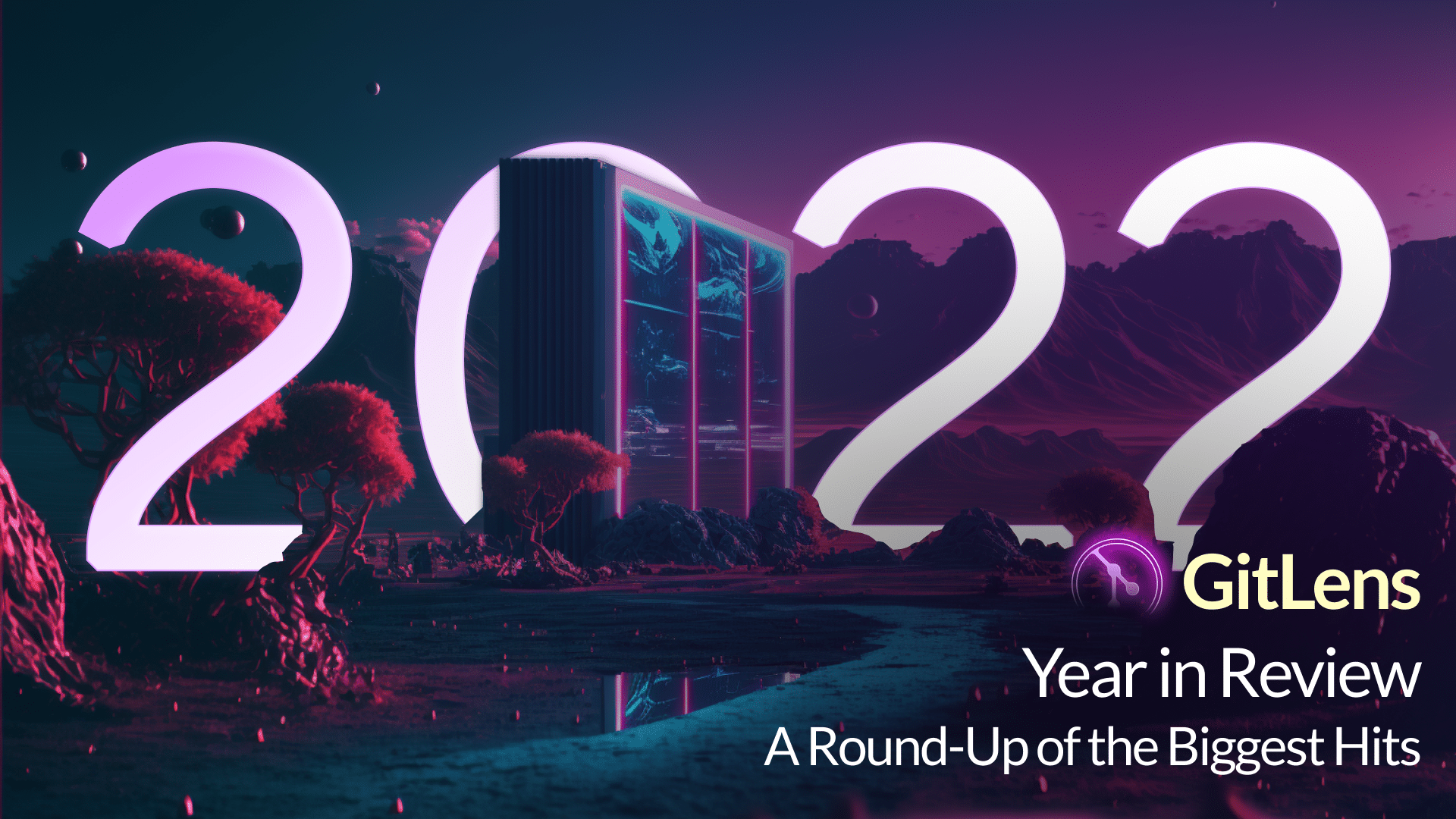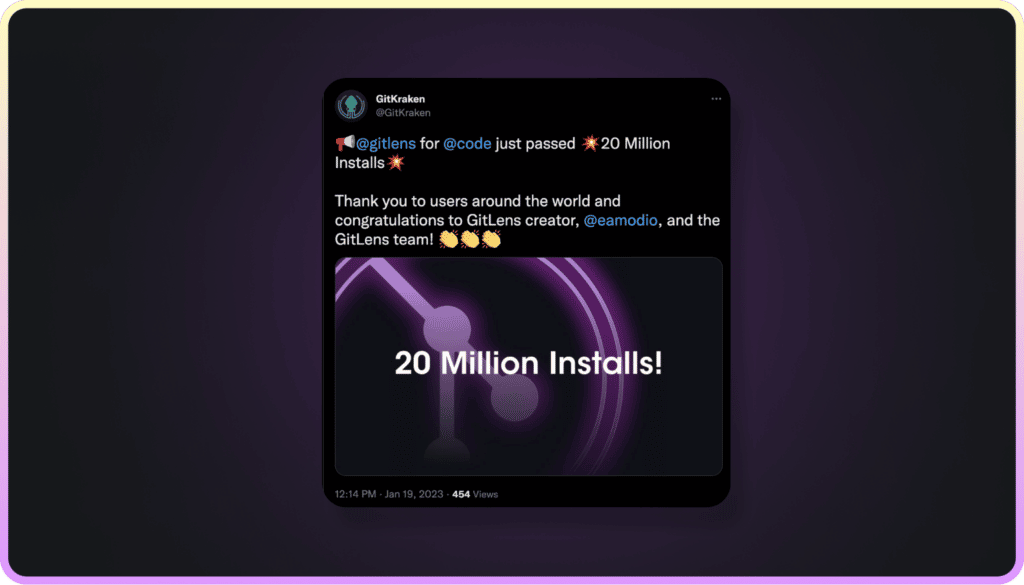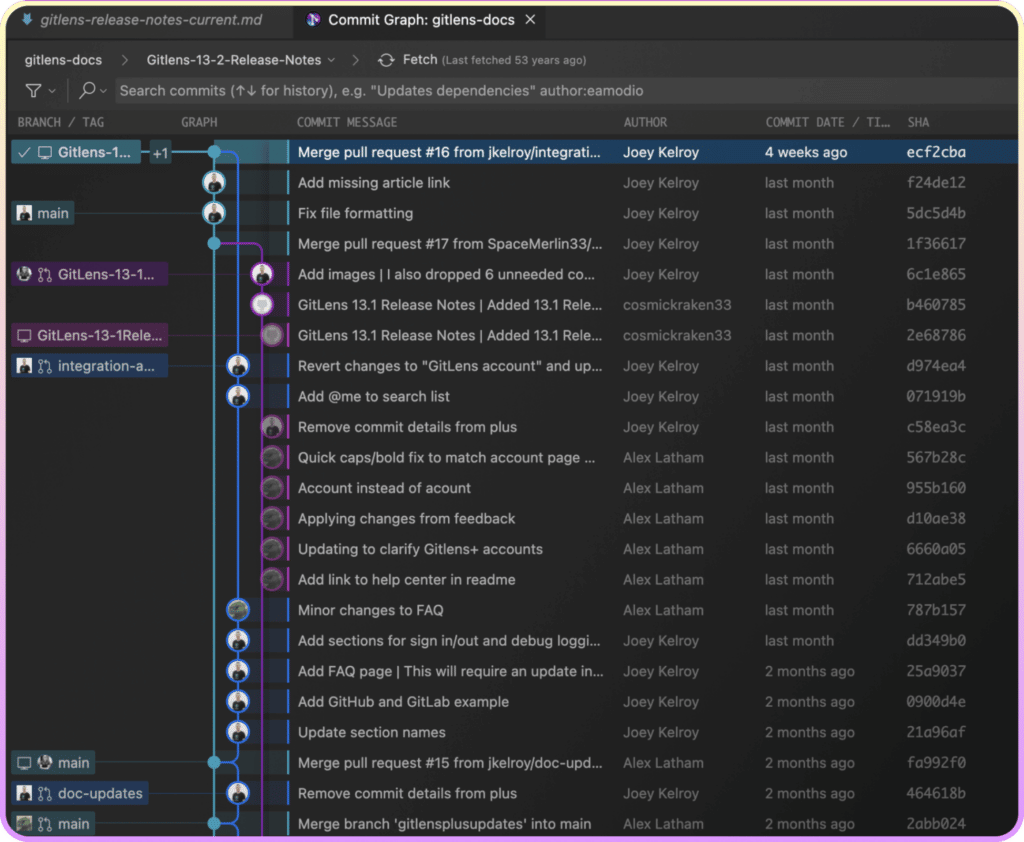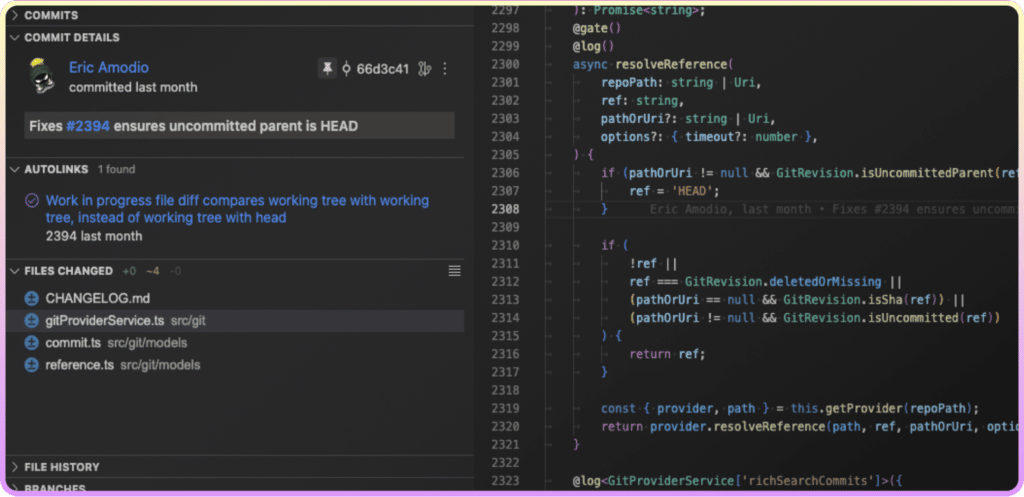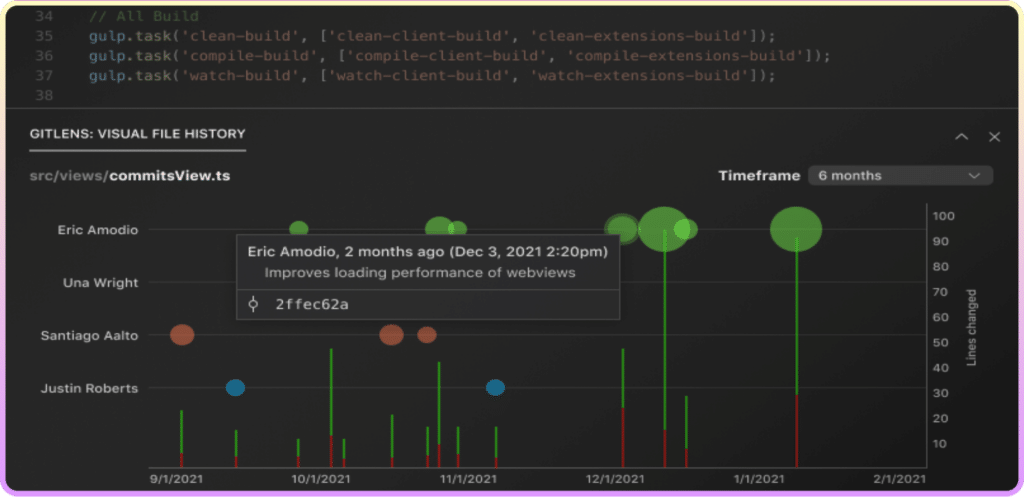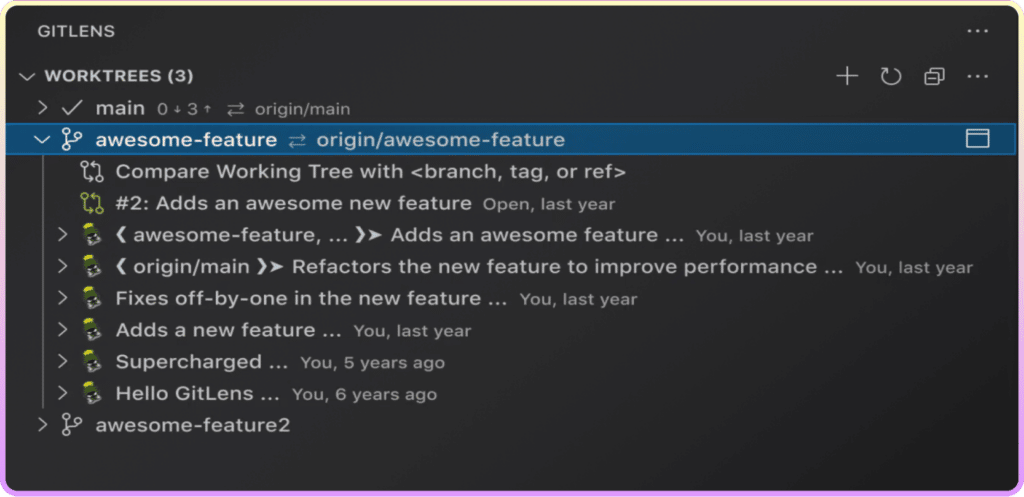Happy New Year! GitLens had a busy and productive year in 2022, with two major releases and several brand new feature additions. Let’s take a look back on the highlights of the past 12 months. But first things first…
Thank You to all the GitLens+ Adopters
Before we look back at 2022, we want to take a moment to thank all of the early adopters of GitLens+ for your commitment and enthusiasm. We are incredibly grateful for your support in continuing to make GitLens the best and fastest growing Git extension on the VS Code marketplace.
With two major releases, the launch of GitLens+, and GitLens for VS Code for the Web, 2022 was a banner year for GitLens. We also just crossed another major milestone—20 million installs! This is a testament to the power of the GitLens community, and we thank you all for being part of that journey. We look forward to continuing to build amazing things together. Now on with the highlights from 2022.
✨GitLens+ Features Launch
With the release of GitLens 12, we added an all-new set of powerful features that enhance your current GitLens experience, dubbed GitLens+ features. The first GitLens+ features we introduced were the Visual File History view and Worktrees. At the time of release, these features required a free account for access on locally and publicly hosted repositories, while a paid account was needed on privately hosted repositories.
However, when we released GitLens 13 in October—debuting the beautiful new Commit Graph—we wanted everyone to benefit from the powerful GitLens+ features on local and public repositories without any friction. So, we removed the free account barrier. Now the only requirement for access to GitLens+ features is having a Pro account for private repository use.
Our intention with GitLens+ features is to create a sustainable model that allows us the ability to continue to heavily invest in the free and open source core of GitLens—features that enable greater productivity, safety, ease-of-use, and more—while creating a set of additional, but completely optional, features designed specifically for professional developers and teams.
To help you identify GitLens+ features, they are marked with a ✨symbol.
✨Commit Graph
In GitLens 13, we reimagined the powerful and beautiful Commit Graph from the GitKraken Client and brought it into GitLens, and even improved upon it along the way! The easy-to-use Commit Graph helps you visualize and keep track of all work in progress. You can also quickly see the relationships between commits, view commit details, and interact with branches, commits, tags, and more through full featured context menus. This can help you and your team better understand the history of a repository and make it easier to identify changes, revert mistakes, and collaborate with others.
We also brought GitLens’ powerful commit search to the Commit Graph to make it more accessible and visual. Use the rich commit search to find exactly what you’re looking for. Its powerful filters allow you to search by a specific commit, message, author, a changed file or files, or even a specific code change.
As a GitLens+ feature, the Commit Graph is freely available to all GitLens users working on local and publicly-hosted repositories, while privately-hosted repositories require a Pro account.
GitLens on The Web
In GitLens 12, we added support for VS Code for the Web, a complete in-browser code editing experience. This was a massive endeavor, as GitLens was built around having access to Git, which isn’t possible on the web. But it was well worth the effort to be able to bring the power of GitLens to everyone via vscode.dev and github.dev.
GitLens for VS Code for the Web is all about bringing the power of GitLens to everyone, expanding access to beloved features like inline blame, blame annotations, heatmaps, and history navigation. GitLens 13 also brought the new Commit Graph to the web as well!
To get to the VS Code for the Web experience, simply navigate to a repository on github.com and press . and you will jump right to it. Once you are in VS Code, install GitLens from the Extensions view as you would on the desktop and GitLens will be available from then on.
Now on the web, GitLens has you covered when viewing or editing GitHub repos, on github.dev and vscode.dev.
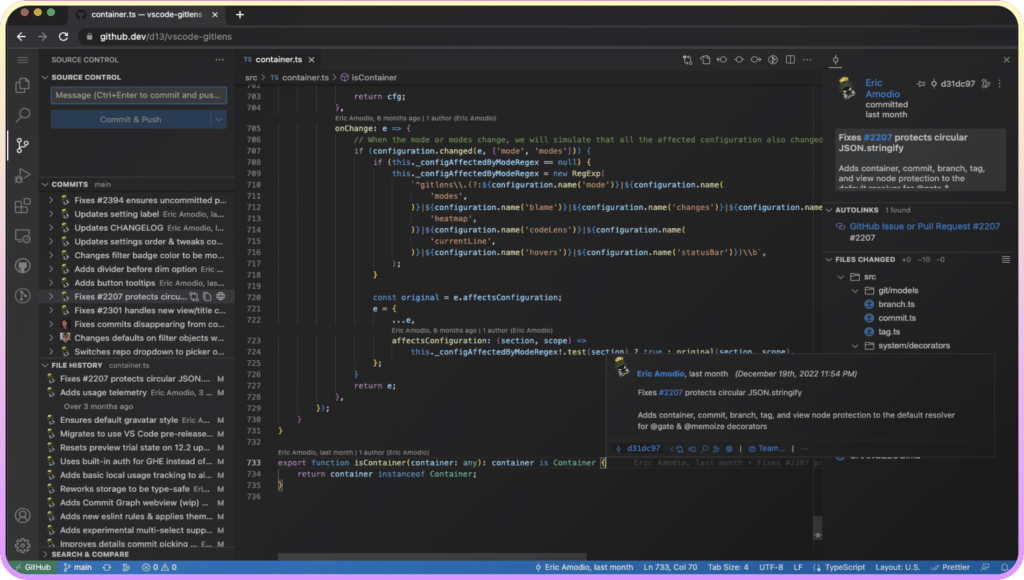
Features Highlights
Commit Details
Released in GitLens 12.2, the Commit Details view provides rich details about commits and stashes. Quickly view information about the commit’s author, commit ID, links to associated issues and pull requests, changed files, and more.
When unpinned, the Commit Details view contextually follows you while navigating through files in the editor as well as selecting commits and stashes within the ✨ Commit Graph, Commits view, Stashes view, Interactive Rebase Editor, and the ✨ Visual File History. You can also open a commit or stash in the Commit Details view from the hovers, context menus, and quick pick menus.
✨Visual File History
Another new rich visualization feature added in GitLens 12 is the Visual File History, which provides insight into how a file changed over time. The Visual File History view allows you to quickly see the evolution of a file, including when changes were made, how large they were, and who made them. Use it to quickly find when the most impactful changes were made to a file or who best to talk to about file changes and more.
✨Worktrees
GitLens 12 also added support for Git Worktrees, which allow you to have multiple branches checked out at the same time. Worktrees help you multitask by minimizing the context switching between branches, allowing you to easily work on different branches of a repository simultaneously. Avoid interrupting your work in progress when needing to review a pull request. Simply create a new worktree and open it in a new VS Code window, all without impacting your other work.
Integrations
We added some valuable new integrations in GitLens 12.
✨GitHub Enterprise and GitLab Self-Managed Integrations
With a Pro account, GitHub Enterprise and GitLab Self-Managed users can see avatars for commit authors, rich details for auto-linked issues and pull requests, as well as pull requests associated with commits and branches.
Gerrit and Google Source Integrations
Contributions by GitLens community members (@felipecrs) and (@andrewsavage1) added support for Gerrit and Google Source remote providers.
Thank You to the GitLens Community
Special thanks to the awesome GitLens community and to the following code contributors to GitLens!
(@felipecrs) Felipe Santos
(@mcy-kylin) mcy-kylin
(@Brcrwilliams) Brian Williams
(@barneycarroll) Barney Carroll
(@rasa) Ross Smith II
(@smartinio) Sam Martin
(@tylerLeonhardt) Tyler James Leonhardt
(@rzhao271) Raymond Zhao
(@dimaulupov) Dmitry Ulupov
(@markjm) Mark Molinaro
(@yrtimiD) Dmitry Gurovich
(@alwinw) Alwin Wang
(@adaex) Aex
(@slavik-lvovsky) Slavik Lvovsky
(@Git-Lior) Lior Kletter
(@tamuratak) Takashi Tamura
Looking Ahead
That was a quick look back at everything we shipped in 2022, but we are most excited about everything we have in store for you in 2023 and beyond.
One of the first things we are working on and shipping soon is bringing the power of Workspaces to GitLens. With Workspaces, you’ll be able to easily focus on the issues and the pull requests that are important to you.
We love listening to the GitLens community; considering the suggestions and ideas that you share with us. We also plan to more deeply engage with the GitLens community as we “design in the open” more – posting ideas and mocks for early feedback. The Commit Graph was our first experiment with that and we found your feedback invaluable. Our team looks forward to the continued discussions and ideas for improving GitLens.
Happy coding!
For more 2022 GitKraken product highlights, read our annual round-up blog posts on GitKraken Client and Git Integration for Jira.
 GitKraken MCP
GitKraken MCP GitKraken Insights
GitKraken Insights Dev Team Automations
Dev Team Automations AI & Security Controls
AI & Security Controls